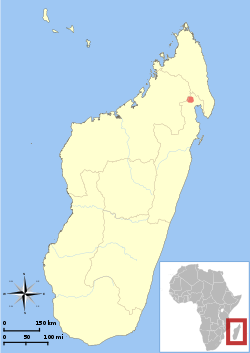| MacArthur's mouse lemur | |
|---|---|
| Scientific classification | |
| Kingdom: | Animalia |
| Phylum: | Chordata |
| Class: | Mammalia |
| Order: | Primates |
| Suborder: | Strepsirrhini |
| Family: | Cheirogaleidae |
| Genus: | Microcebus |
| Species: | M. macarthurii |
| Binomial name | |
| Microcebus macarthurii Radespiel et al., 2008 [3] | |
 | |
| Distribution of M. macarthurii [1] | |
MacArthur's mouse lemur (Microcebus macarthurii), or the Anjiahely mouse lemur, is a species of mouse lemur known only from Makira Natural Park in northeastern Madagascar. [4]
The species is named in honor of the founder of the MacArthur Foundation, which financed the studies that included the discovery of this species. [4]
